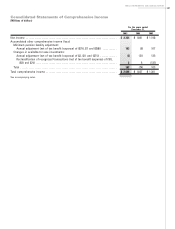Texas Instruments 2005 Annual Report Download - page 18
Download and view the complete annual report
Please find page 18 of the 2005 Texas Instruments annual report below. You can navigate through the pages in the report by either clicking on the pages listed below, or by using the keyword search tool below to find specific information within the annual report.
Amortization of leasehold improvements is computed using the straight-line method over the shorter of the remaining
lease term or the estimated useful lives of the improvements.
Assets held under capital leases are recorded at the lower of the net present value of the minimum lease payments or
the fair value of the leased asset at the inception of the lease. Amortization expense is computed using the straight-line
method over the shorter of the estimated useful lives of the assets or the period of the related lease.
Change in Depreciation Method: Effective January 1, 2006, as a result of a study made of the pattern of usage of our
long-lived depreciable assets, we will adopt the straight-line method of depreciation for all property, plant and equipment.
Under the new provisions of SFAS No. 154, “Accounting Changes and Error Corrections, a replacement of APB Opinion No.
20 and FASB Statement No. 3,” which become effective as of January 1, 2006, a change in depreciation method is treated
as a change in estimate. The effect of the change in depreciation method will be reflected on a prospective basis beginning
January 1, 2006, and prior period results will not be restated. As the results of our study indicated that the current
estimated useful lives of our assets were appropriate, the depreciable lives of property, plant and equipment assets will not
be changed. We believe that the change from the 150 percent declining-balance depreciation method to the straight-line
method will better reflect the pattern of consumption of the future benefits to be derived from those assets being
depreciated and will provide a better matching of costs and revenues over the assets’ estimated useful lives.
Investments: All investments in equity and debt securities are classified as available-for-sale except for investments in
certain mutual funds (described below) that are held to offset deferred compensation liabilities. Equity investments held
at December 31, 2005 and 2004, include publicly traded marketable securities and private investments, which are
generally non-marketable. Investments in marketable equity and debt securities are stated at fair value, which is based
on market quotes where available or estimates by investment advisors or management, as appropriate. Adjustments to
fair value of these investments are recorded as an increase or decrease in the accumulated other comprehensive
income section of stockholders’ equity except where losses are considered to be other than temporary, in which case
the losses are recorded as expenses in other income (expense) net. Marketable securities are considered other-than-
temporarily impaired if they have traded below cost basis for more than six months.
Investments in non-marketable equity securities, primarily comprised of investments in early stage development
companies and various venture capital funds, are stated at historical cost and are subject to a periodic impairment
review. Any impairment considered other than temporary is recorded in other income (expense) net. Cost or amortized
cost, as appropriate, is determined on a specific identification basis.
Investments in certain mutual funds are classified as trading and are stated at fair value. These mutual funds hold a
variety of debt and equity investments and are intended to generate returns that offset changes in certain liabilities
related to deferred compensation arrangements, thus are classified as a long-term investment. Adjustments to fair value
of both the mutual funds and the related deferred compensation liabilities are recorded in SG&A expense (see Note 14
for a discussion of Deferred Compensation Arrangements).
Goodwill and Intangible Assets: Goodwill is not amortized but is reviewed for impairment annually, or more frequently if
certain indicators arise. We complete our annual goodwill impairment tests as of October 1 of each year for all our
business segments, which have been designated as reporting units based on an analysis of economic characteristics and
how we operate the business. This annual test is performed by comparing the fair value for each reporting unit to its
associated book value including goodwill. For each of the periods presented, the fair value exceeded the carrying value
including goodwill, therefore no impairment was indicated.
Intangible assets are amortized on a straight-line basis over their estimated lives. Fully amortized intangible assets are
written off against accumulated amortization.
Changes in Accounting Standards: In December 2004, the FASB issued SFAS No. 151, “Inventory Costs, an amendment of ARB
No. 43, Chapter 4,” which will become effective for us beginning January 1, 2006. This standard clarifies that abnormal
amounts of idle facility expense, freight, handling costs and wasted material should be expensed as incurred and not included
in inventory. In addition, this standard requires that the allocation of fixed production overhead costs to inventory be based on
the normal capacity of the production facilities. We have completed the evaluation of the impact of this standard on our
financial position and results of operations, and have concluded that the impact of the change will not be material, as the
normal capacity rate to be used is not materially different from the optimal capacity rate that we previously used.
16
TEXAS INSTRUMENTS 2005 ANNUAL REPORT
























